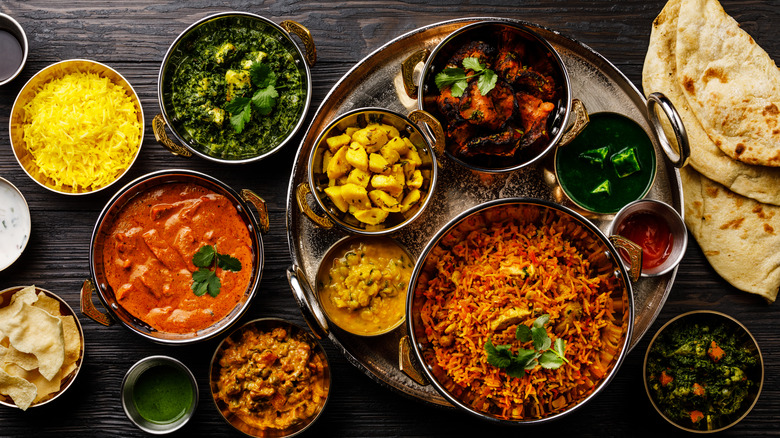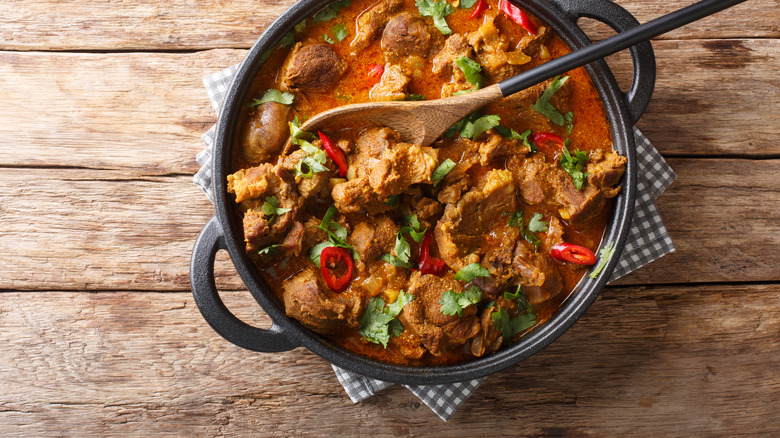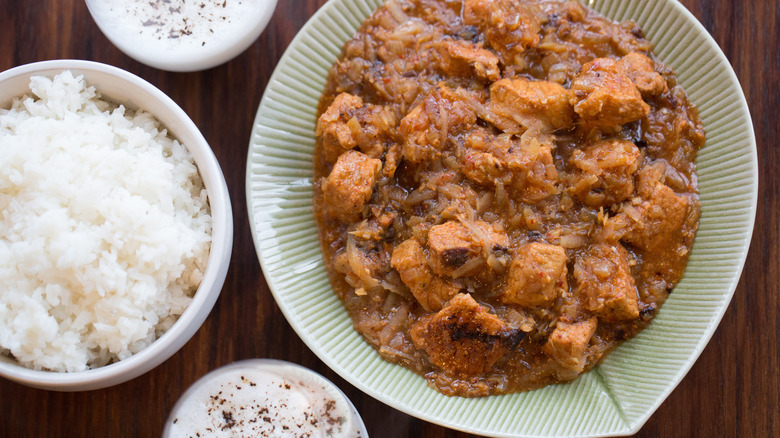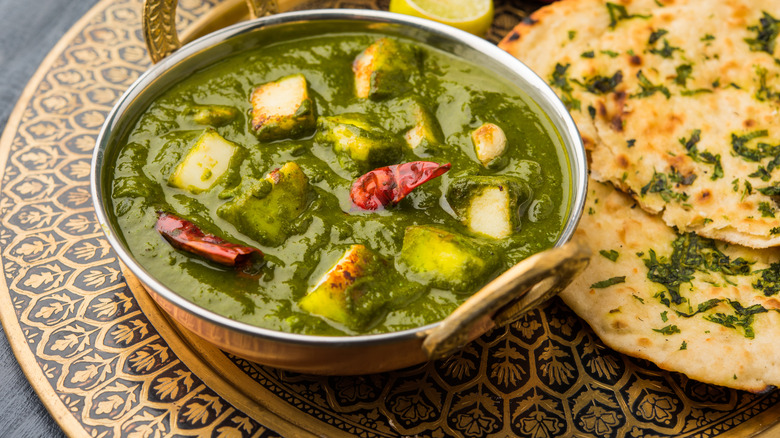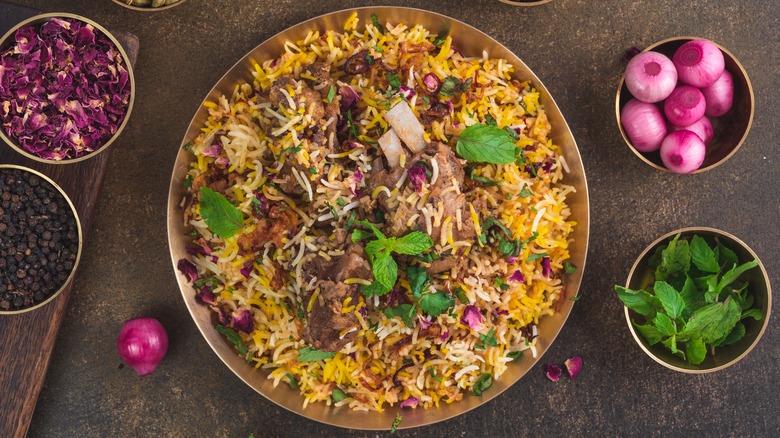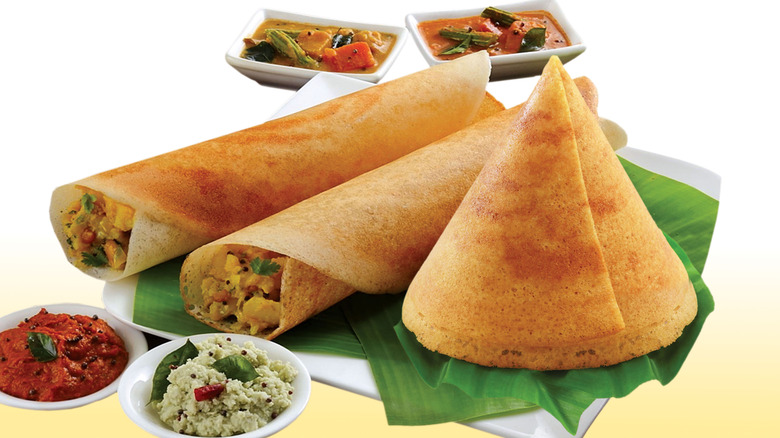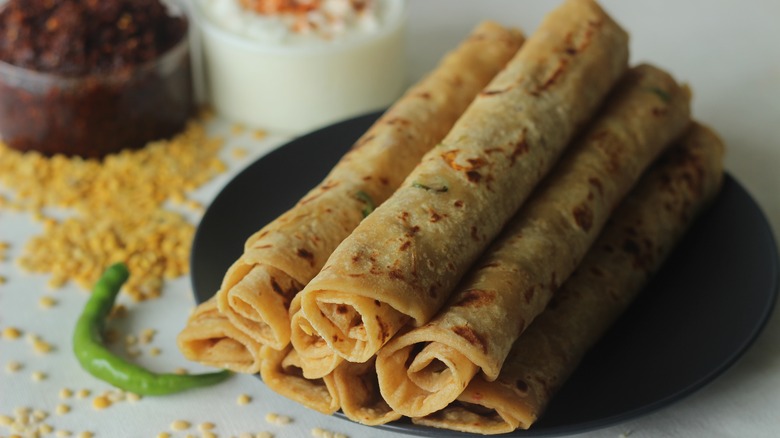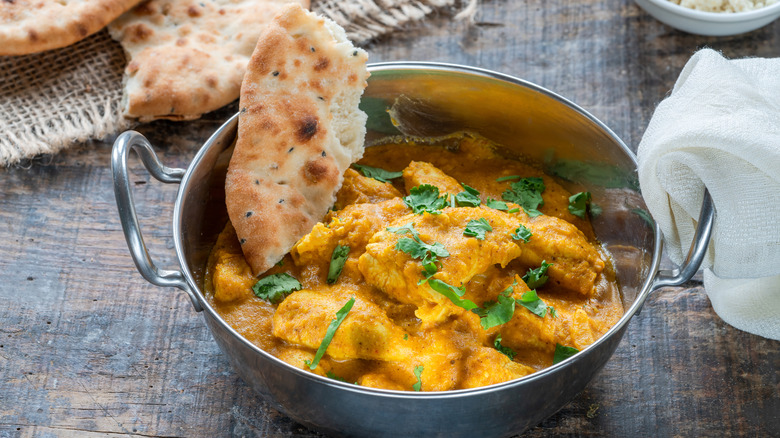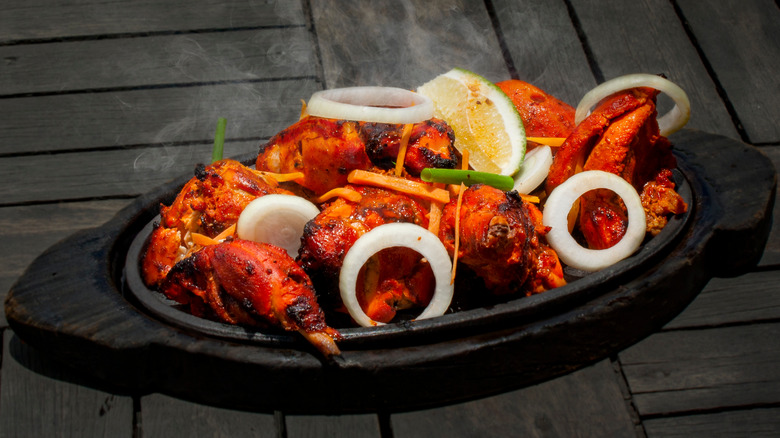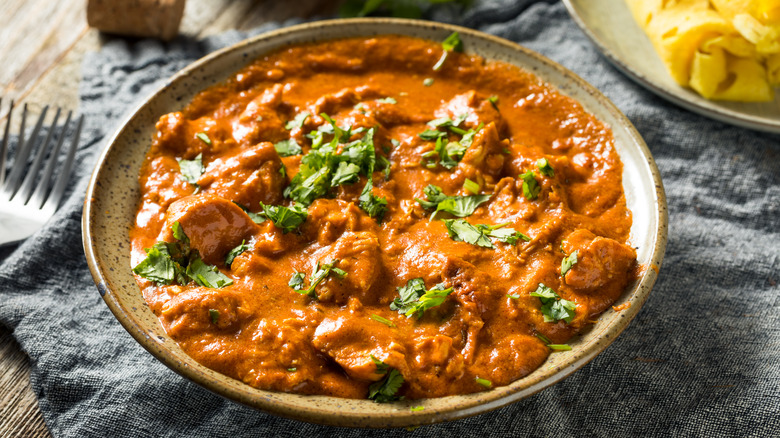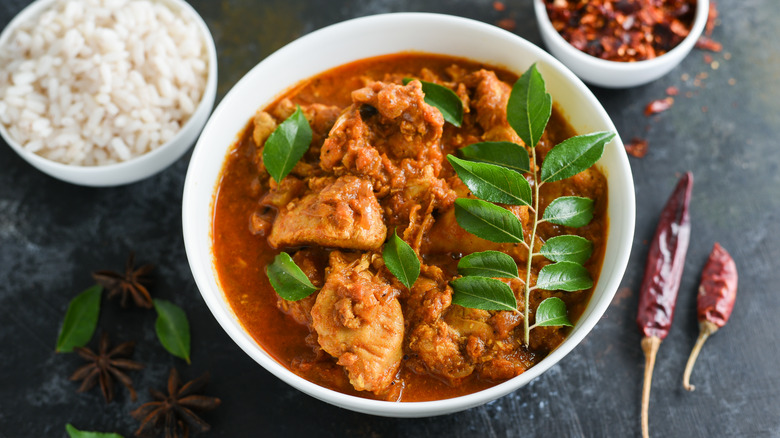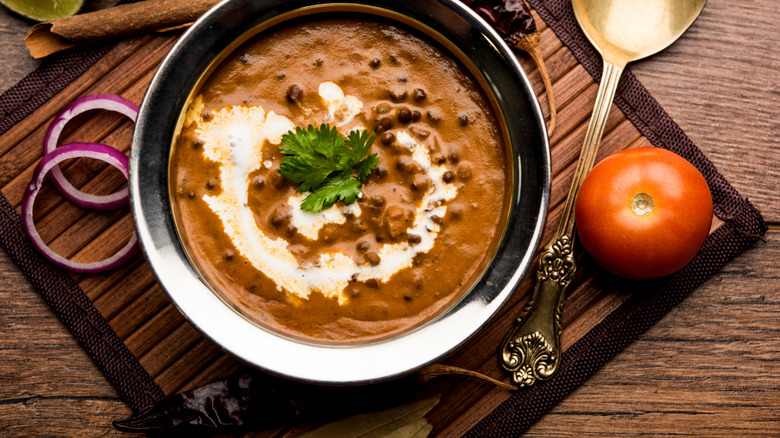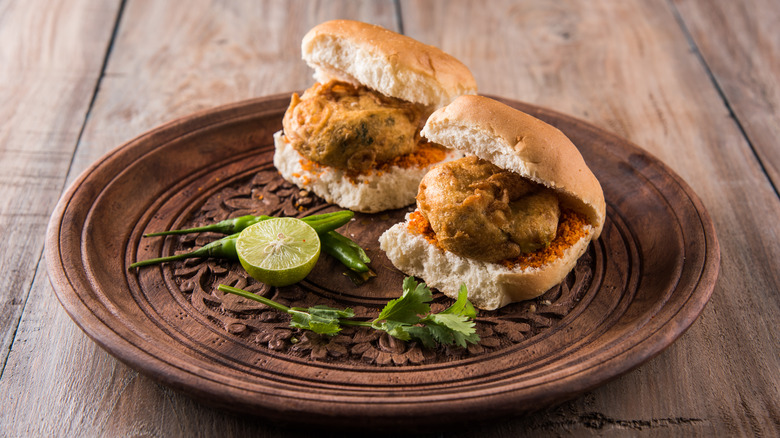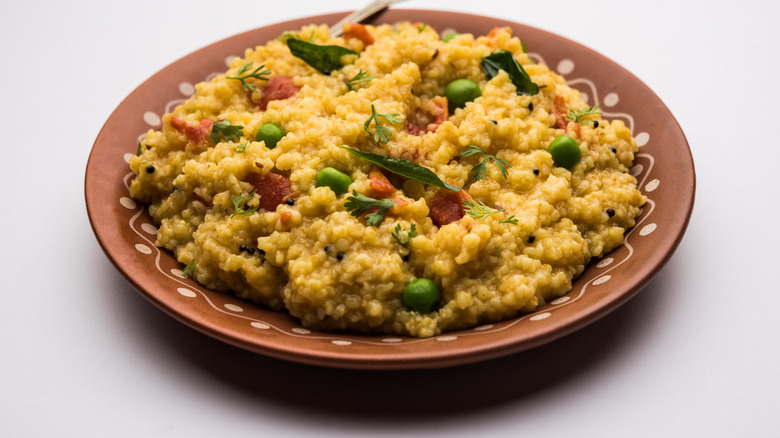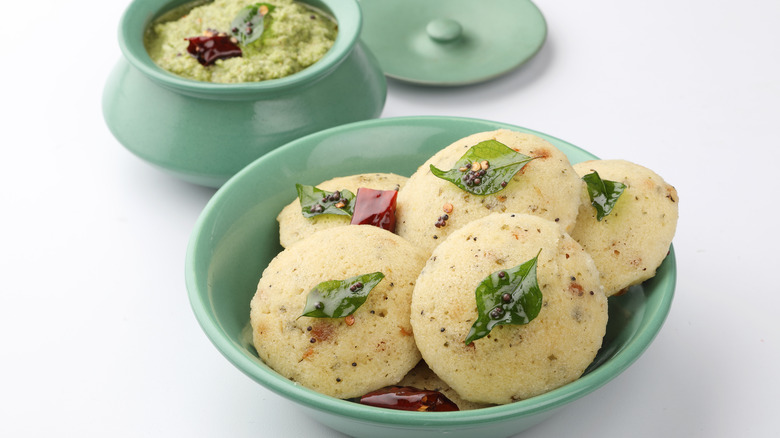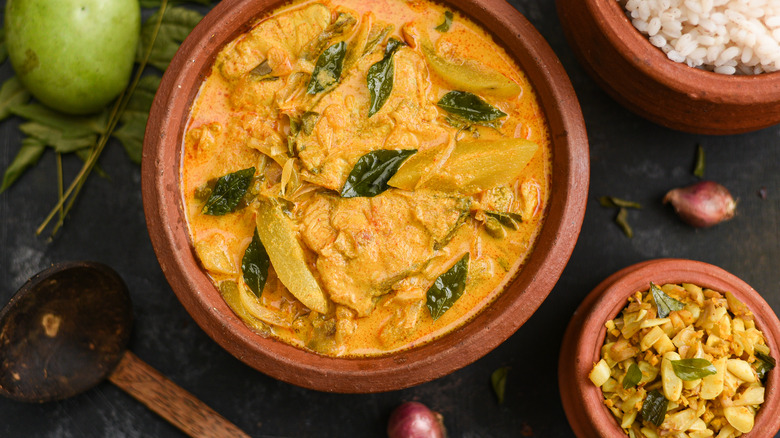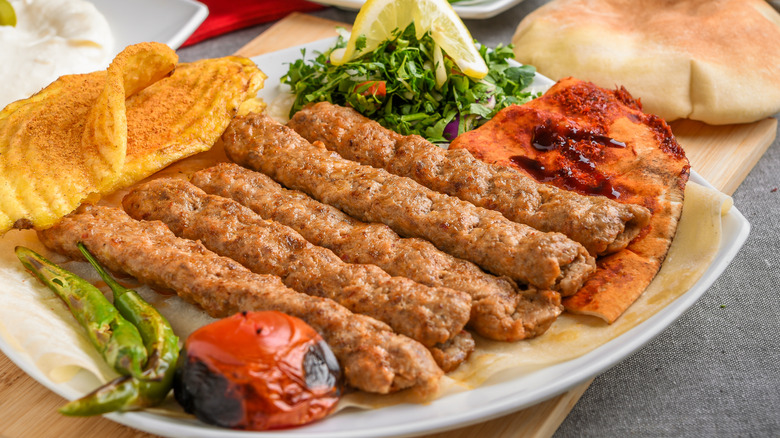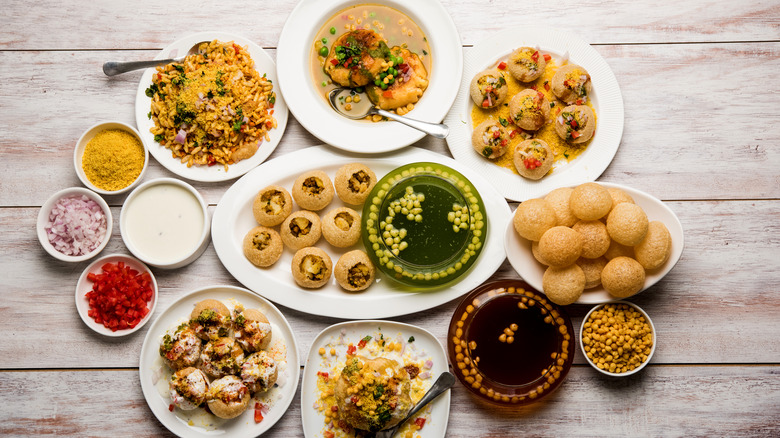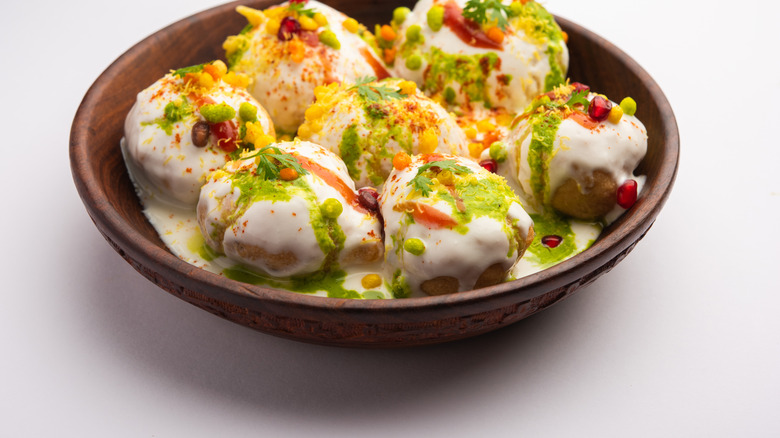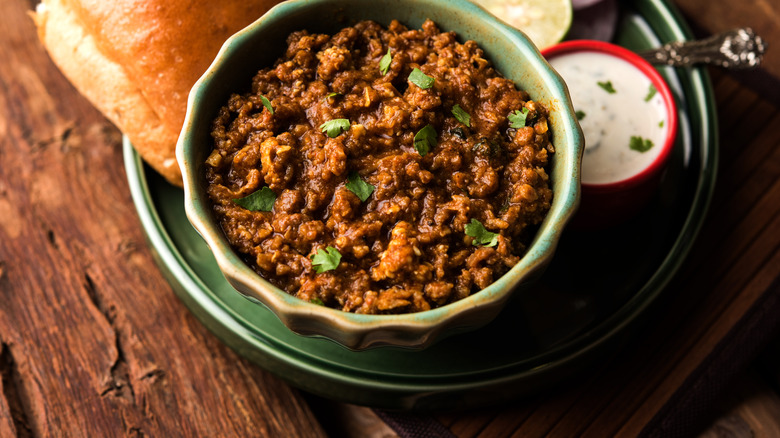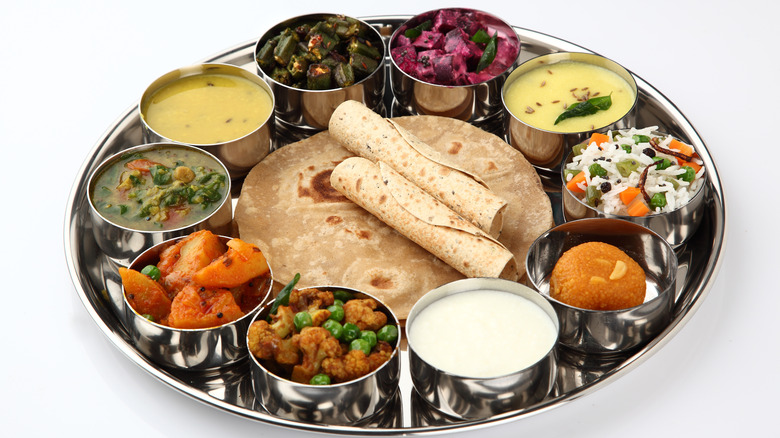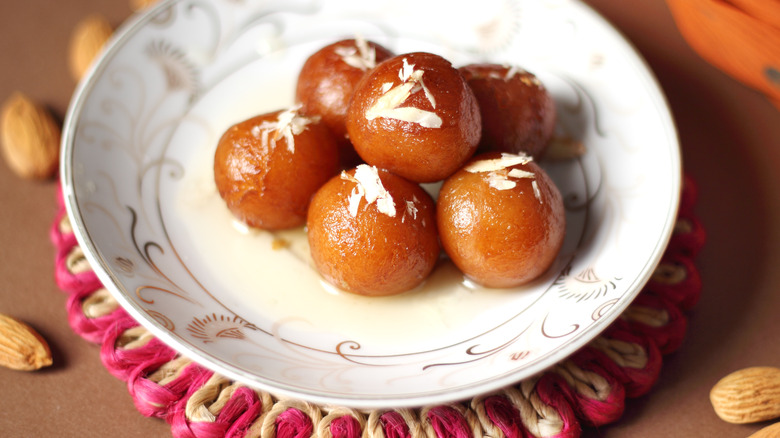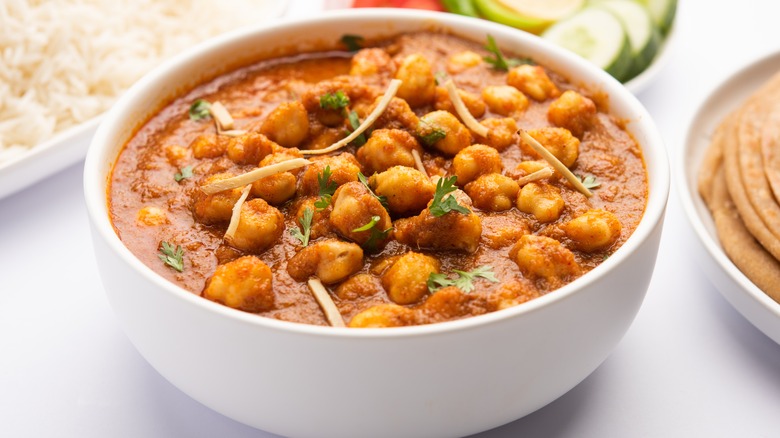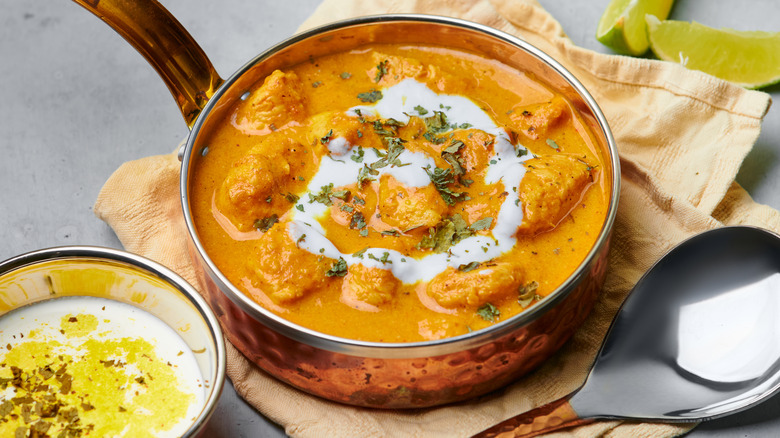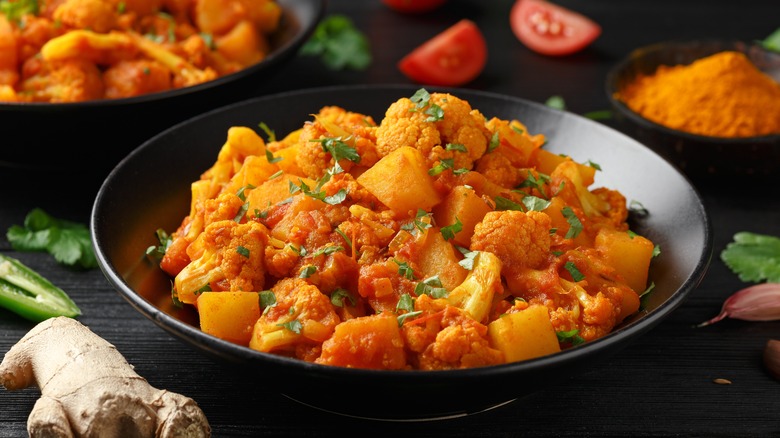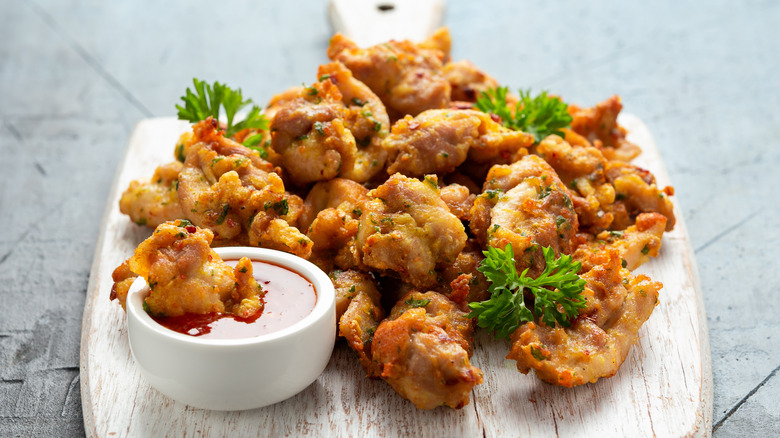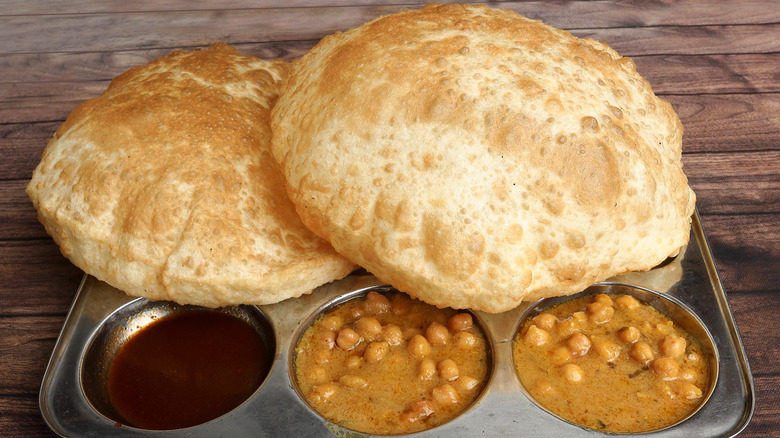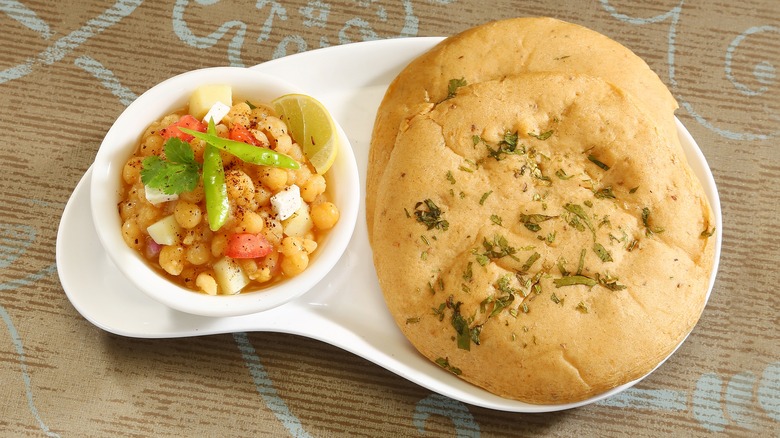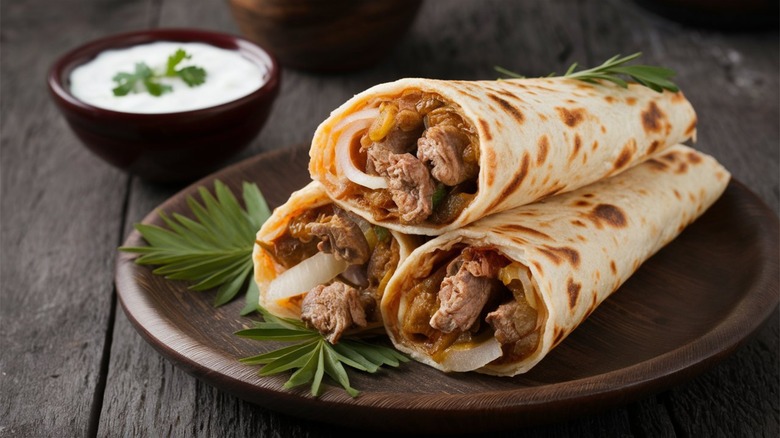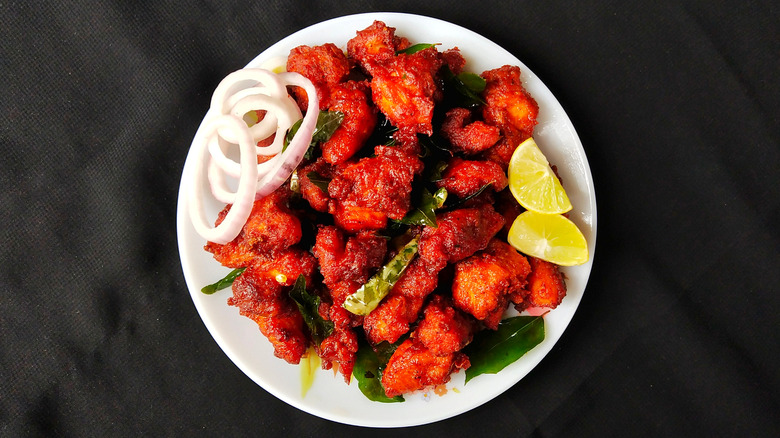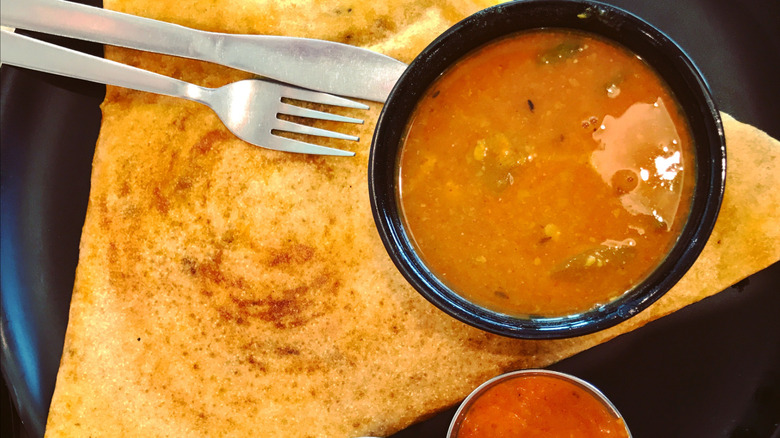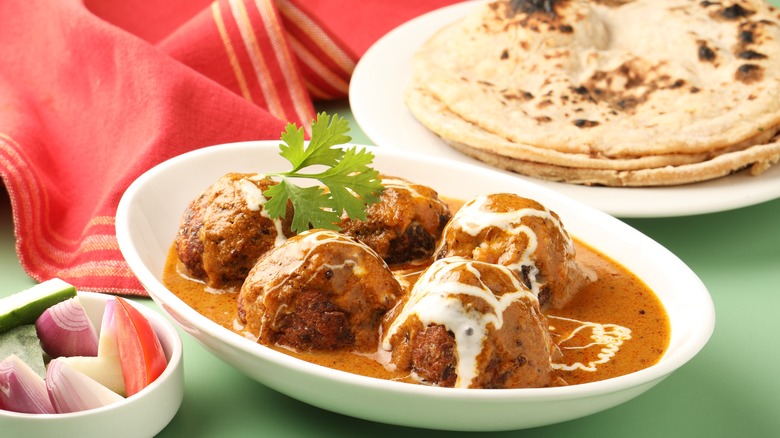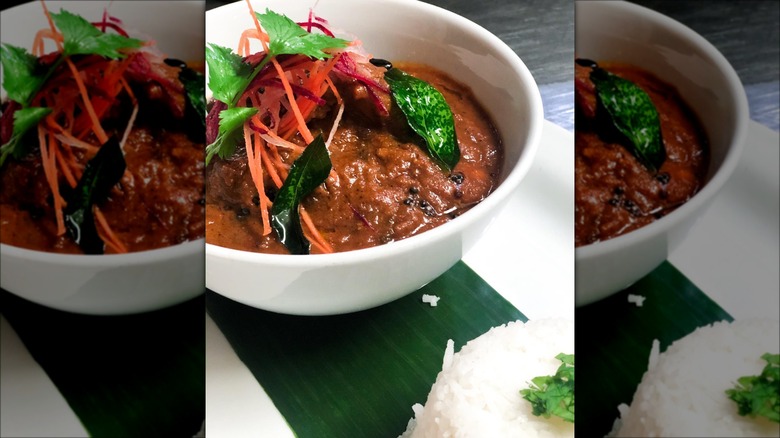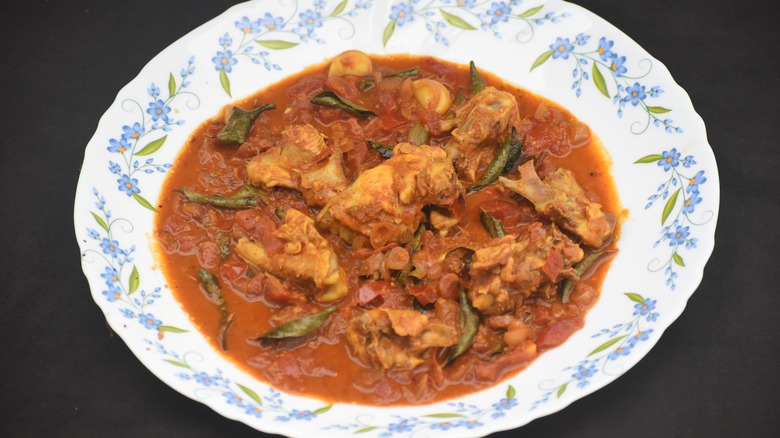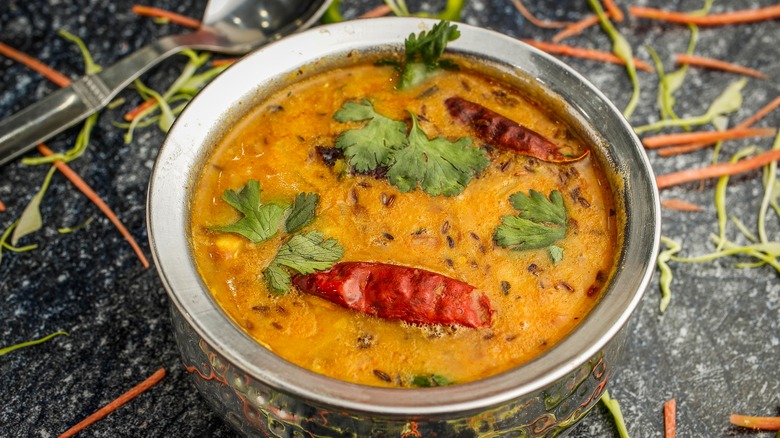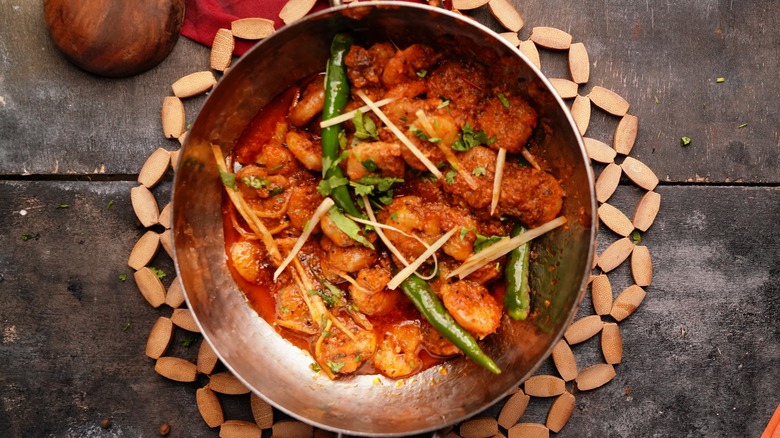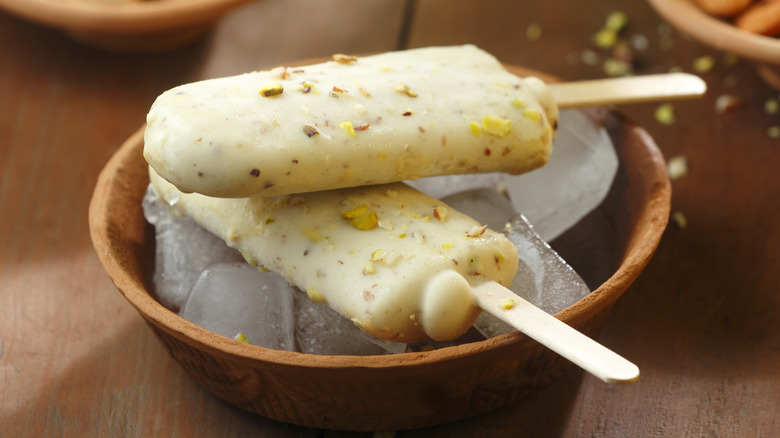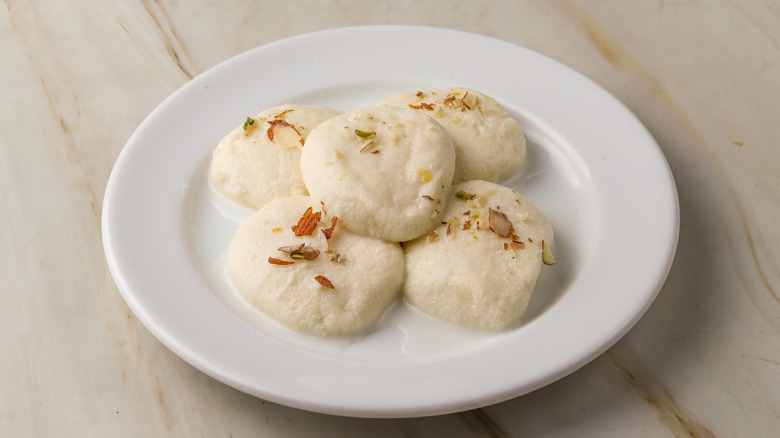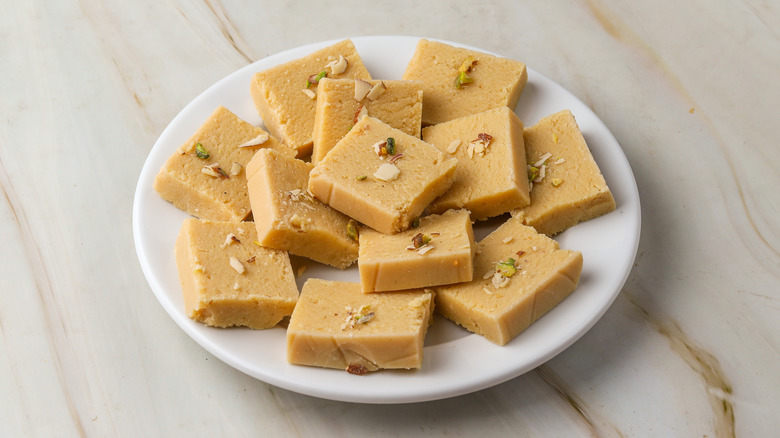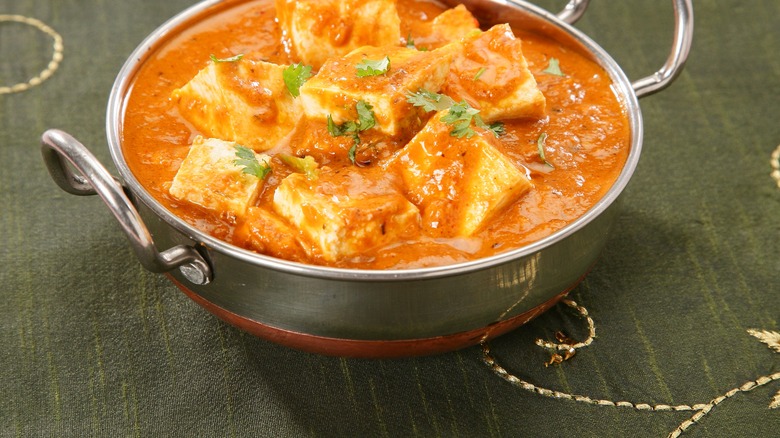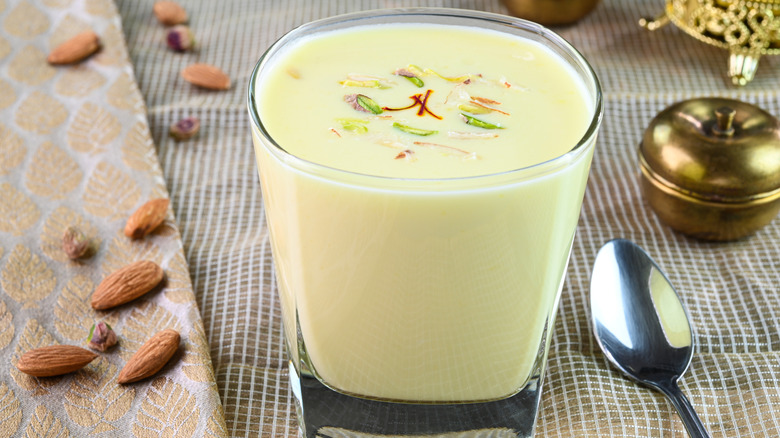40 Delicious Indian Dishes You Have To Try At Least Once
When you're in the mood for a meal loaded with contrasting flavors, textures, and an element of novelty, the same old options just won't cut it. Looking to cultures around the world for culinary inspiration is an exciting way to stimulate your taste buds. And while there are flavorful dishes to try from numerous countries, India is home to some of the most vibrant flavors and spice-forward preparations you will ever taste.
Being such a large country, Indian cuisine is as diverse as its geography. From coastal regions serving seaside fare to mountainous areas where fresh produce is hard to come by, there's always a new dish for you to try. Whether you can travel to the lively country and experience the local cooking firsthand or are trying to pick from a restaurant menu or cookbook, there are some dishes you'll want to check off your Indian cuisine bucket list. We've created a selection of the top Indian foods to try as a way to start your journey into the many flavors available. From classic items with their own regional variations to recipes inspired by British rule or neighboring countries, these are the essential dishes you have to try.
Rogan josh
If you're looking for a rich stew that will wrap you up in a warm hug, a serving of rogan josh will definitely hit the spot. The name doesn't come from a man called Josh; instead, it provides a hint as to its preparation and flavor. In Persian, rogan means clarified butter (or ghee), and josh refers to fiery heat, two characteristics of this dish. Also, in Hindi, rogan translates to the color red, which is a fair description of the vibrant curry. Nowadays, rogan josh is typically associated with the Kashmiri region in northern India.
Aside from the two features that give this dish its name, let's dive into the other elements: Goat, or lamb, is simmered in a savory ghee-based gravy, which includes aromatic ingredients such as onions, garlic, ginger, spices (cinnamon, clove, cardamom), and yogurt as a thickener. Some regional variations incorporate tomato into the sauce, and the list of spices is flexible; however, Kashmiri chilis are often a mainstay. As the meat cooks, it becomes perfectly tender and flavorful, resulting in a delicious stew that requires little more than basmati rice or naan bread to be complete.
Vindaloo
Although it has the reputation of being one of the spiciest curries around, there's more to vindaloo than meets the eye. The Goan specialty likely descends from the Portuguese, who introduced a vinegar- and garlic-marinated meat preparation to India in the 15th century. The dish quickly took on Indian elements, replacing the vinegar with palm wine, adding tamarind, and blending in spices such as black pepper, cardamom, cinnamon, and chili peppers (the latter was another gift from the Portuguese). Vindaloo, at the time, consisted of pork cooked with a subtle balance of aromatics, but when it ended up in England a couple of centuries later, it transformed into an in-your-face hot curry.
Along with the shift in flavors, vindaloo in Britain at the end of the 20th century was closely tied to British lad culture. More specifically, instead of enjoying the nuances of the spices, the goal became making vindaloo as spicy as possible and competing to see who could finish a bowl of the stuff. The English soccer team even incorporated a reference to vindaloo into their anthem at the 1998 FIFA World Cup. If you're able to find a version of the dish more akin to the Goan classic, do yourself a favor and savor the sweet-and-sour feast.
Palak paneer
If you find it hard to load up on greens, palak paneer is the best way to get your fill. Palak translates to spinach, and paneer is a semi-firm, fresh-pressed cheese. The result is a delicious combination that might make you consider pairing the two all the time. Paneer doesn't melt when heated; instead, it retains its cubed shape as it stews in the spinach, providing textural contrast. Aside from pureed spinach and fresh cheese, some cream, onion, ginger, garlic, and garam masala all contribute to the flavor and rich consistency. The spice profile can vary from kitchen to kitchen, making every palak paneer preparation distinct.
The origin of this vegetarian dish can be placed in the Punjab region in northern India, where it is also called saag paneer, referring to the variety of leafy greens that can be used. Palak paneer has rural origins, typically prepared to nourish people working labor-intensive agricultural jobs. Thanks to the paneer, this dish makes a solid vegetarian main, especially with its typical accompaniments such as rice or bread. However, it's also the perfect green side dish for a meat main or as part of a larger selection.
Biryani
For a delightfully fragrant rice dish that will stimulate all of your senses, biryani is the way to go. As yet another nod to India's mixed history, the dish comes from Iran — birinj biriyan translates to fried rice in Persian. Whereas it transformed into a distinct meal in Iran, Indian biryani developed into an array of rice-based dishes unique to each region. However, the city most associated with the dish has to be Hyderabad. The iconic Hyderabadi version boasts extra tender meat and warm spices such as cinnamon, cloves, cardamom, and, most importantly, saffron.
Regardless of the specific origin, some elements are common to all preparations of the dish. Saveur lists basmati rice (usually long-grain), meat (such as chicken, mutton, beef, and seafood in coastal areas), a yogurt marinade, a blend of aromatic whole and ground spices, and toppings like nuts, dried fruits, caramelized onions, and fresh herbs to garnish. As for the preparation, there are three standard approaches: slow-cooking parboiled rice and raw marinated meat together, layering raw meat and uncooked rice, or partly cooking the two elements separately and steaming them together. No matter the components and cooking method, expect deep, complex flavors and a meal that will satisfy you on all levels.
Masala dosa
Think of it as southern India's take on a pancake, except that it's thin like a crêpe and typically served with savory fillings. Unlike flour pancakes, dosa batter is made from fermented lentils and rice, producing a crispy exterior and a softer interior. One origin story to explain the source of the name (dosha means to sin) tells of a Brahmin cook who was experimenting with fermented rice and ended up with an altogether different product than the alcohol he was secretly trying to make. You'll be happy to skip the rice wine once you get a bite of this versatile snack.
The variations are abundant, and popular fillings include onions, potato, chutney, coconut, and fresh coriander. As for masala dosa, which is commonly eaten in Mysore, you'll generally find it either stuffed with potato curry and butter or with an assortment of chutneys, including tomato, mint, and coconut. The result is perfect to temporarily satiate your appetite at any time of the day, and it's even gluten-free. Plus, thanks to the fermentation process, you can expect some gut-friendly bacteria in your meal.
Breads
There are at least 30 kinds of bread in India, specific to certain areas and made with various flours and cooking methods. One should be sure to experiment widely. Naan bread is probably the easiest one to find in the U.S., which is a huge plus since the fluffy texture and charred top are hard to beat. The leavened bread is made with flour and traditionally cooked in a tandoor oven, served hot with melted ghee on top. Stuffed naan or plain renditions are perfect for mopping up a rich sauce.
On the other hand, parathas skip the leavening process, and the wheat dough is brushed with ghee and continuously folded over itself, much like a puff pastry. The flaky, crispy flatbread is enjoyed from breakfast to dinner, either plain and served with savory dishes or stuffed with fillings, including potato, minced meat, and eggs.
Meanwhile, roti (also called chapati) is as important to a meal as rice, which means a lot in a country that comes second in global rice consumption. Whole wheat flour, water, and salt are mixed to make chapati, then cooked in a hot skillet. Plain roti is perfect for scooping up stews and saucy dishes, and the whole wheat flour adds a pleasant nuttiness.
Korma
Once again, we see an intermingling of cultures in this Persian Indian dish. Korma is a rich, smooth stew, typically made with meat, although vegetarian adaptations exist. Chicken, mutton, beef, paneer, or vegetables — the choice is yours. The flavor is all in the nuances of aromatic spices here, and saffron, coriander, cumin, turmeric, and ginger are some of the usual suspects. Although yogurt is commonly used to thicken the sauce, regional swaps such as coconut milk, cream, or reduced milk and other components like ground nuts, dried fruits, and spices may also vary depending on where you're eating.
The result is velvety, nutty, mildly spiced, with a hint of sweetness that ties it all together. Although korma isn't usually spicy, renditions from Southern India may pack in a bit of a kick. The word korma, which can be traced to the Urdu language, means to braise, which is part of the method that leads to tender, flavorful meat. The savory stew is commonly served with flatbread, such as chapati, naan, or paratha.
Tandoori chicken
Bright red tandoori chicken is easy to recognize and harder to forget once you taste the delicious preparation. The flavor comes from both the yogurt and spice marinade, as well as from the cooking method. Chicken (usually on the bone) is cooked in a tandoor oven made from clay, which imparts smoky aromas and infuses the meat with flavor. The exterior of the meat gets nice and crispy, while the insides are juicy and tender from the marinade. The spice mix (tandoori masala) varies, but common elements are cayenne, garlic, ginger, onion, garam masala, and red chili powder.
Tandoor ovens are typically used for baking bread, but Kundan Lal Gujral was the first to cook chicken this way in Pakistan in the first half of the 20th century. He soon had to escape Pakistan and ended up in Delhi, where he popularized the heavenly dish. While that's possibly the origin of the modern-day recipe, remnants of clay ovens with chicken bones dating back to around 2500 B.C. have also been unearthed. It's not hard to understand why such a preparation would be so popular. Pair tandoor chicken with naan bread for a delightfully smoky and savory meal.
Chicken tikka masala
Tandoori chicken led to many other dishes that make use of the smoky flavors, spice blend, and yogurt marinade. Chicken tikka masala is one such example, and among the more accessible items to find at Indian restaurants in the U.S. Unlike tandoori chicken, which is served dry, chunks of boneless, cooked tandoori chicken are finished in a creamy tomato sauce. The specific nuances of the sauce vary depending on who's cooking, but tomato puree, cream, coconut milk, turmeric, and paprika are commonly used.
The origin of chicken tikka is debated; however, one thing agreed upon is that it's considered to be one of the first recipes combining British and Indian cuisine. In fact, in 2001, British Foreign Secretary Robin Cook even dubbed it the country's national dish, adding that "it is a perfect illustration of the way Britain absorbs and adapts external influences" (via The Guardian). That may be so, though chef Satpal Sharma tells the South China Morning Post that everything about the preparation and ingredients is Indian. Consider the discussion, then savor the rich stew with naan bread or rice.
Madras curry
Madras curry begins with a heavenly blend of ground spices by the same name. As with other well-known Indian dishes, it became popularized by the British, who labeled all curries from the city of Madras as such. The dish we now know was developed in the 1970s in the U.K. in an effort to simplify the spectrum of Indian curries to local customers. Madras curry was intended to be hot and spicy, in contrast to milder stews like korma. The heat level can vary, and raita (yogurt with cucumbers and mint) is often served alongside to offset the intensity. Let's not forget naan bread and rice, which are the perfect starchy complements to the savory stew.
The spice blend is flexible, but common components are cumin, coriander, cloves, fenugreek, mustard seeds, ginger, and red chilis. In fact, crushing the red chilis produces the bright red color typical of a Madras-style curry. Apart from the layers of spices, the base of the stew is made with onions, garlic, ginger, tomato paste, and coconut milk. The chicken is the meat of choice here, and if lamb or beef are substituted, it becomes ghoust Madras.
Dal makhani
Dal makhani is sure to be a favorite for vegetarians and meat eaters alike. It turns out the same cook believed to be responsible for bringing tandoori chicken to our plates is also behind the savory lentil dish. From Western Punjab and Pakistan to Delhi, dal makhani is thought to have been a resourceful way to avoid waste. It is said that Kundan Lal Gujral first combined tandoori chicken with a creamy tomato sauce, and his grandson later blended the family dal with the sauce to make dal makhani.
The stew is made from red kidney beans and black lentils (known as urad), resulting in a thick consistency. While dal refers to the lentils, makhani means butter — a nod to the ghee-heavy preparation that is garnished with more butter or yogurt. Aside from the rich base, dal makhani consists of ginger, garlic, and chilis cooked in tomato sauce. The savory lentil stew is best served with one of countless regional flatbreads and can be enjoyed as a side with meat or as a vegetarian main.
Vada pav
If this is India's answer to burgers, you might want to reconsider your beef-eating habits. Vada pav is closely intertwined with the city of Mumbai, with an estimated two million units sold per day locally. The vegetarian snack consists of a spiced potato patty coated in chickpea flour, fried, and stuffed into a soft bun. Chili, coriander, and garlic chutney act as condiments flavoring every starchy bite. You can bet individual cooks put their spin on the tasty snack, but there's no need to get fancy with the ingredients — simple and classic is best.
Vada pav was first sold outside a busy train station in the 1960s, quickly becoming the perfect snack with its contrasting textures and flavors. Although the dish is iconic in Mumbai, both the bread and potatoes that make up most of the content were imported from Europe. At one point, McDonald's even tried to re-create the popular item but lacked the flavor nuances that make each vada pav unique. August 23 is celebrated as vada pav day, a symbol of the love for this delightful and convenient street food.
Khichdi
This timeless dish goes by plenty of names, and they're all delicious. Khichdi, khichari, khichadi — they all describe the nourishing rice and lentil dish popular across South Asia. A taste for khichdi starts young, and it's often the first food babies eat thanks to the soft texture. What it's lacking in texture is more than made up for by the fragrant spices that flavor the dish, including cinnamon, cloves, bay leaves, and peppercorn. As a contrast to the mild flavors of the dish, chutneys, yogurt, and pickles are often served alongside.
The one-pot meal is typically enjoyed during the monsoon season in the region of West Bengal in Eastern India. There's nothing like a warm bowl brimming with nutritious ingredients to distract you from the constant downpour. For other people, khichdi is synonymous with comfort food, often served if someone is feeling slightly ill. Whether you're looking for a bland dish to combat an upset stomach or prefer something more elaborate and aromatic, there's a style of khichdi for you. Per The Better India, historian Mohsina Mukadam says that khichdi is "one of the most ancient foods in India, yet one that has hardly changed." Given the vast spread of this popular Indian dish, the original recipe is evidently a winner.
Idli
Don't let idli lovers hear you calling it boring — as one British professor quickly found out after making a comment that received some traction on social media in 2020. As with many staples that seem like they were always a part of the dining table, the details of the origin of idlis are uncertain. Historians suggest the dish might have come from Indonesia, whereas others believe it has Arab origins. Although you're sure to come across many variations, at its most basic, idli batter is made from fermented lentils and rice, which is then steamed into patties.
Perhaps eaten solo, one could describe it as bland, but idli shines thanks to its accompaniments like chutney, vegetable stew, and assorted sauces. The batter is sometimes seasoned, and you might even be surprised with a savory filling. While the typical method is to steam the cakes, some styles are fried. Soft cakes are commonly served at breakfast as a filling and comforting start to the day.
Goan fish curry
With such a lengthy coastline, it's no surprise that some of the best Indian specialties involve fish. Among the numerous renditions, Goan fish curry is high on the list. Firm-fleshed white fish is commonly used, but in her cookbook "The Ultimate Curry Bible," Madhur Jaffrey suggests using the freshest fish possible, so check for the local daily catch. Whatever fish is used, it's cooked in a spice-forward sauce, which might include garlic, chili, turmeric, chili, coriander seed, and cloves.
What really gives the curry an edge, however, is the use of tamarind pulp to add a pleasantly sour tang. Next, coconut (shredded, cream, or milk) is incorporated into the dish, highlighting the fruit's abundance in Goa. The sauce often incorporates tomato and onion, and the fresh flavors of curry leaves are always welcome. After the fish simmers in the creamy, fragrant sauce, it is garnished with fresh cilantro and typically served with rice. The only way for this dish to get better is to enjoy it on a beach in Goa.
Seekh kebab
The birthplace of kebab is probably in Turkey; however, the preparation has since made its way around the world. The name comes from cabob, which means to char or burn in Arabic. True to its name, kebab meat is grilled over a flame, lending a smoky flavor and charred appearance. As for seekh kebabs, some historians recount that Genghis Khan's soldiers found themselves using the end of their swords (seekhs) to cook spiced meat in a fire, giving the dish its name.
Over time, the recipe evolved, and seekh kebabs are now usually made with minced lamb or mutton that is seasoned with onion, garlic, ginger, yogurt, garam masala, and coriander. The meat is skewered and cooked on a grill as an easy dish served with salad, mint chutney, and other sides, including flatbreads. Recipes have also started catering to vegetarians, and paneer and vegetables are regularly skewered and grilled. Whether you enjoy kebab as an appetizer before heartier fare or have it as your main course, you're sure to be satisfied.
Chaat
Although chaat entails a wide range of snacks commonly sold by street vendors, a few elements tie them all together. Various tales describe the origin of the dish, but many suggest that the vibrant assortment of spices was used to counter the high doses of bacteria in local food and water. Chaat means to lick or taste, a hint that you'll probably want to lick your fingers to get the most out of this snack. Some form of fried dough is a typical component, enhanced with spicy, sour, sweet, and salty toppings. Common to many dishes is a powder known as chaat masala, which contains spices such as cumin, coriander, mango powder, pepper, black salt, and mint.
For many, the magic of chaat is in the contrasting flavors and textures. Starting with a starchy base, vegetables, chutneys, and chaat masala are loaded on next, finishing it all off with a crispy topping. Popular flavors include potato-based aloo chat, bhel puri (puffed rice with nuts, chutneys, and fresh coriander), pani puri (hollow bread shells with mixed fillings), samosas, and the list goes on. Do yourself a favor and try as many of these treats as possible — you won't regret it!
Dahi vada
Dahi vada has a long history; by some accounts, it was first mentioned in writing sometime around 500 B.C. This delicious and colorful dish is typically enjoyed during the festival of colors known as Holi. The balanced combination of ingredients in this tasty snack is considered ideal for cooling off during the celebrations that comprise the event. To prepare dahi vada, yogurt (dahi) is served over fried lentil balls (vada) for a filling bite that can easily be customized. Depending on the style, the balls might be made up of different grains, and the yogurt is sometimes replaced with curd.
Find it served with chili, cumin, coriander, and, of course, a variety of chutneys. Refreshing toppings like pomegranate seeds, mixed fruit, or fresh ginger add a pleasant contrast. Not to mention, the colorful add-ons contribute to the dish's festive air, and aside from Holi, it is also served at a number of celebrations. Whether you enjoy it on a special occasion or grab the street food at a corner stand, you're sure to love the spectrum of flavors.
Keema
Sometimes, it's all about the simplicity of a well-prepared dish. Keema means minced meat, which is a fundamental component of the recipe. Lamb, goat, or beef are typically used, and the dish is cooked like a curry with ginger, chili, onions, garlic, and mixed spices. Expect many variations, often helpfully included in the name (if you understand the language, that is).
Keema matar (minced meat with peas) has a hint of sweetness and freshness from the vegetables. Meanwhile, keema pav is served on the same square bun used for vada pav; think of it as a take on a Sloppy Joe. For a flaky fried snack, you'll want to try a samosa stuffed with keema. Or, just enjoy it simply with naan bread or mixed into biryani.
You're best off being invited for dinner to enjoy keema, as the Hindustani Times explains that it is hard to come by in restaurants. Speaking with two top Indian chefs, the publication reports that keema is thought of as a poor man's dish, made from discarded cuts of meat. As well, the oils from the meat tend to collect, giving it a slick appearance that is unappealing to many. Unlike curries, which use oils to flavor and build up the sauce, it's more obvious with keema since the focus is minced meat. Regardless, set aside any hesitations and dig into a delicious plate.
Thali
Think of thali as your very own personal feast on a platter. In fact, in Hindi, the word refers to the steel plate on which the meal of the same name is served. An assortment of 10 to 15 dishes can be doled out on your plate, usually contained in small bowls. You'd better have an appetite to savor the mix and match of items, which can include curry, dal, pickle, chutney, fried snacks, bread, rice, and yogurt. There are dozens of other preparations, including meat, vegetables, fish, and seafood ... not to mention desserts.
Spicy, sour, sweet, salty, and bitter tastes are all present on the plate, and as such, the dish often serves a palate cleanser as a common addition. This careful balance of flavors is in line with Ayurvedic principles regarding proper nourishment. Aside from the harmonious combinations, a central component of thali is the focus on fresh, seasonal, and local ingredients. The colorful meal is traditionally served at celebrations such as weddings. For a true taste of regional Indian flavors, start off by savoring thali.
Gulab jamun
Although Indian cuisine is well-reputed for its rich curries and heavy spice profile, the sweets shine in a category of their own. Attend any festival in India or sit through a long meal, and you'll likely come across gulab jamun, one of the most recognizable desserts on the subcontinent. Its origins appear to trace back to a Persian treat, though the recipe underwent some changes when it came to India.
Gulab jamun translates to rose plum, referring to the rose water syrup used to soak the treats and the way the round balls look like small plums. The orbs are made by cooking milk solids (curds) and mixing them with flour to make a dough. Sugar is sometimes added, too, producing a darker color as it caramelizes during the cooking process. The balls are deep-fried and then soaked in syrup commonly flavored with rose water, though variations with spices like cardamom or saffron are also popular. The final texture is moist and fluffy, with a pleasant stickiness infused with fragrance.
Chana masala
Chickpeas, aka chana, are the star of the show in this deeply flavored stew. Although chana masala originates from the north of India, it is now commonly found in other areas as well as on restaurant menus stateside. The dried legume is cooked with a blend of spices referred to as a masala. While masalas vary widely in flavor, in this dish, you'll typically find notes of cumin, coriander, turmeric, cardamom, clove, cinnamon, and bay leaf, as well as aromatics like onion, ginger, and garlic. The base of the sauce tends to incorporate tomatoes, and fresh coriander leaves tie it all together.
As they cook, the chickpeas gently simmer and absorb all the rich seasonings, resulting in a vegetarian dish that could easily win over a few carnivores. Rice is a natural accompaniment to the savory stew, and it is also served with bread, such as naan, to mop up the sauce. You'll find variations of the hearty vegetarian meal, with extra add-ins like spinach leaves or coconut milk to bulk it up, all of which make for an ideal Indian dish for dinner.
Murgh makhani
Possibly the most beloved menu item at Indian restaurants in the U.S., butter chicken, aka murgh makhani, is indeed eaten in India. Although it often gets a bad rap from foodies looking for a unique dining experience, its history places it firmly among the iconic dishes of India. As with most widely popular things, the inventor of butter chicken is disputed, though it is generally agreed it was created at a restaurant in Delhi. The original recipe was whipped up to stretch out slightly dry leftover tandoori chicken by adding it to a spiced tomato gravy with butter and cream to bulk it up.
Nowadays, the variations are plentiful, and recipes incorporate other ingredients like vegetables, nuts, and raisins. Though the traditional version consists of chicken marinated in yogurt and spices and cooked in a tandoor oven, an easy shortcut is to grill, roast, or saute it after marinating it. You can order the dish on a scale from mild to spicy, but a lingering sweetness and silken creaminess are common to all. Served with rice or naan to wipe up the extra sauce, this classic comfort food shows up around the world.
Aloo gobi
A reliable side dish pairs well with a large variety of mains, and that's certainly the case with aloo gobi. Named for its two main ingredients (potatoes and cauliflower), this tasty duo provides both a vegetable and starch component to round out your meal. The classic vegetable recipe was first created in the Punjab region in northwestern India, though nowadays you'll find it all over, including at Indian restaurants in the U.S. It's also commonly seen in Pakistani cuisine, a nod to the overlapping culinary traditions.
This flavor-packed dish is loaded with spices like cumin, turmeric, chili powder, fenugreek, and coriander. For extra richness and texture, you'll also find garlic, ginger, and onion. Although it contains some tomato puree, this vegetable curry tends to be drier. Among the recipe variations, some versions include coconut milk to make a saucier style, while others fry the vegetables before adding them to the sauce.
Pakora
It's hard not to love crispy deep-fried snacks, which is probably why pakoras are a popular favorite across India. Also known as bhaja, bhajia, and bhonda, these terms encompass a category of food with a similar preparation: Sliced vegetables are coated in a chickpea flour batter and fried until golden. Although vegetables like onions, potatoes, cabbage, cauliflower, and spinach are traditionally used as the bulk of the snack, modern recipes swap them out for chicken and fish, too. Pakoras can vary in size, but they're typically just the right amount to be served as an afternoon bite with a cup of chai.
If you find yourself in a home kitchen in India at the right time, you may be lucky to snag some freshly fried pakoras. This is especially true during monsoon season when the crunchy treats are especially widespread and enjoyed as a warming food thought to help absorb fat-soluble vitamins. Otherwise, they are commonly sold at street stands along with hot tea and chutney for dipping. In some cases, a plate stacked high with pakoras is one component of a full-course meal, though we would imagine it takes willpower to add more wholesome sides like steamed rice and stewed vegetables to your plate.
Although written evidence is lacking, some food historians believe that pakoras are the precursor to Japanese tempura. The explanation stems from the fact that there were no similar foods in Japan until the Portuguese arrived in the 16th century with culinary knowledge from India.
Chole bhature
Chole bhature is a Punjabi recipe and a meal in one, consisting of deep-fried leavened bread and a spiced tomato and onion chickpea mixture. In fact, the name spells out the components of the dish, as chole means chickpeas and bhature refers to the specific type of bread, typically made from a yogurt-based dough. The former is quite similar to chana masala, that aforementioned (and common) spiced chickpea dish served with rice or other flatbreads. Chole bhature tends to be saucier, providing the perfect counterpart for the fluffy fried bread.
According to some accounts, the dish became popular in the late 1940s, when a Punjabi father and son began selling it from a small food stand in Delhi. Nowadays, it's a typical item at roadside restaurants, and there are plenty of variations, with some preparations leaning more heavily on spices, whereas others emphasize tangier flavors. Served for breakfast alongside lassi or for lunch or dinner, this hearty meal is sure to satisfy your hunger.
Matar kulcha
This popular Delhi street food consists of peas and flatbread, per the direct translation of its name. The peas are cooked as a tangy curry and typically kept warm in large brass pots, making it easy to serve from a roadside stand. The duo of legumes and slightly leavened bread is similar to chole bhature, except for the specifics. White peas are the legume of choice for matar kulcha, whereas the bread can be seasoned with herbs, spices, or even stuffed. The bread is soft and chewy, puffing up into an airy consistency as it cooks in a hot pan.
Aside from peas, the curry is flavored with plenty of cumin, chili, fennel, cardamom, and garam masala. Additionally, tamarind and dried mango powder (amchur) are responsible for the tangy taste. The dish is typically garnished with fresh ingredients like diced onion, tomato, chili, ginger, lemon juice, and coriander leaves. To finish it off, a mint and coriander chutney blended with lime and chilis adds a kick of flavor.
Kati rolls
Kati rolls are the kind of snack that transcends borders. Originating during British colonial rule in the early 1900s, the spicy wraps were first invented at Nizam's, a restaurant in the city of Kolkata — which, at the time, was India's capital city. British diners were apparently uncomfortable with eating kebabs with their hands and no utensils, so the meat was rolled into a crispy paratha and served wrapped in paper.
The tasty roll quickly moved beyond Nizam's, becoming a popular street food and snack served at stands and restaurants. It isn't as common in other Indian cities, as they have their own rendition of a wrap, but it's becoming internationally recognized thanks to its mass appeal. The kebab meat is commonly topped with a fried egg and seasoned with a dollop of chutney to make the flavors pop. Of course, the traditional version has long evolved to include a wide range of kati rolls, with fillings like chickpea curry and paneer.
Chicken 65
Recipe names often tell a story, and when it comes to chicken 65, it's simpler than you might expect. Instead of the many theories — such as that the chicken is marinated for 65 days or cut into 65 pieces — it's even more straightforward; the popular Indian dish was invented in 1965. At the time, it was created at the Buhari Hotel restaurant in Chennai, where other variations from different years eventually ended up on the menu, too.
Chicken 65 consists of boneless meat marinated in a spiced yogurt mixture containing ginger, garlic, curry leaves, black pepper, cumin, and chili powder. After the meat is sufficiently marinated, it is tossed in rice flour before being deep-fried. The result is tender flavor-packed chicken encased within a crunchy shell. The South Indian dish is commonly served as an appetizer with a squeeze of lemon juice to add some tanginess. It can also be plated alongside white rice or flatbread for a heartier meal.
Sambar
There are endless types of dal in Indian cuisine, and sambar is a delicious version made with tamarind that comes from the south of the country. The recipe was supposedly first prepared for a visiting royal named Samba. Other accounts suggest the variation was created after tamarind was added to a different dal recipe, resulting in a unique dish. Either way, one thing is for sure: The recipe was good enough to become a South Indian favorite.
The lentil stew also contains mixed vegetables, such as okra, carrot, tomato, eggplant, and pumpkin. And let's not forget the seasonings; sambar powder is the go-to blend and consists of several roasted and ground whole spices, including cumin, coriander, fenugreek, mustard seeds, dry red chilis, urad dal, curry leaves, asafoetida, and turmeric. The blend varies a bit depending on who makes it, but it adds warm aromatics and richness to the veggie and lentil stew, which is enhanced with tamarind for a sour touch. Sambar is commonly served with dosas, idli, or rice to sop up the saucy goodness.
Malai kofta
Dumplings come in a wide range of shapes and sizes, and malai kofta is one tasty vegetarian version from Northern India. Made with potato, paneer, corn flour as a binder, fresh coriander, and spices, the dumplings sometimes feature add-ins like finely chopped cashews or raisins. Once they're shaped into balls, they are deep-fried, resulting in contrasting textures between the crisp exterior shell and soft interior. To lighten up the fairly weighty dish, some people choose to cook the dumplings in a pan or air fryer.
The dumplings are served in a subtly sweet and rich gravy made with blended cashews, tomatoes, alliums, aromatic spices like cinnamon and cardamom, and thickened with cream. To maintain the structure of the dumplings, they're mostly just warmed in the gravy rather than being stewed for a lengthy duration. This saucy dish is best served with steamed white rice or naan bread to scoop up the gravy, making it a hearty and ideal Indian dish for dinner.
Karaikudi curry
This curry recipe features plenty of spices, infusing the dish with lots of heat and aromatics, but it's best skipped by people who can't tolerate heat, as it's recognized for being spicy. Originating from the town of Karaikudi in the region of Chettinad in South India, this curry is commonly made with chicken, but the foundation can be used with other proteins like goat meat or paneer.
Red and green chilis bring most of the heat, along with black peppercorns and milder spices like cumin, coriander, fennel, mustard seeds, curry leaves, and coconut — and tamarind sometimes makes an appearance, too. The protein gets a double dose of flavor, first from a lemon and chili marinade, and then from tempered spices cooked along with onions and tomatoes. Finally, the protein of choice is pan-fried with the spiced aromatics, browning the exterior while infusing it with loads of flavor. To counter the bold spices, Karaikudi curry is typically served with fresh coriander.
Chicken Chettinad
Unsurprisingly, chicken Chettinad (or pepper chicken Chettinad) comes from the region of Chettinad. Although chicken Chettinad is quite similar to Karaikudi chicken curry, the latter tends to feature a bolder palate with more intense aromatics and a spicier kick. Chicken Chettinad, on the other hand, is slightly milder (though no less flavorful) and often contains more coconut, which helps balance the heat. Aromatic spices like cloves, fennel, and cinnamon tend to show up in the dish, along with a key ingredient: kalpasi (or, black stone flower). The taste is similar to star anise, and due to the difficulty of sourcing kalpasi, this spice is often used as a substitute.
The recipe can vary substantially depending on the source, but generally, it starts by marinating chicken with yogurt, turmeric, garlic, ginger, chili, and lime. When it's time to cook the meat, a proprietary spice blend and grated coconut are separately roasted. The two are then ground up into a powder that is used to season an onion and tomato sauce, in which the chicken simmers. The saucy dish is completed with a side of naan or rice and a fresh cilantro garnish.
Dal tadka
Dal is a way of life in India, and there are countless variations to the simple dish. Various types of lentils can be featured, along with an array of spices and seasonings to finetune the flavor. In the case of dal tadka, the two lentils commonly used are arhar dal and masoor dal: husked and split pigeon pea and red lentils. Some recipes introduce a smoky element to the dish by smoking charcoal with ghee in a bowl and placing it in the pot of dal to infuse its aromas.
Tadka means tempered, so this recipe consists of spices that are heated in ghee or oil, bringing the aromas to life. Typical seasonings include cumin seeds, asafoetida, garlic, ginger, fenugreek, and chili peppers. Once tempered, the spices and the oil are mixed into the pot of cooked lentils, adding a burst of toasted spice flavors. Dal tadka pairs well with rice, naan, or roti, and with special occasions — it was apparently first served in the fourth century B.C. at a wedding.
Kadai chicken
Also known as karahi chicken, this popular Indian dish is named after the wok-like pan used to cook it. The recipe was first developed for royalty, but nowadays, it's a staple in Indian homes, especially in the north of the country. There's no bland-tasting chicken here — instead, the meat is marinated in rich spices to infuse it with plenty of flavor. Ginger, garlic, red chilis, and salt give it a boost of flavor from the get-go. Next comes the kadai masala, a special blend of spices intended solely for this dish. It typically consists of red chili powder, coriander, cumin, fennel, black peppercorns, and cardamom.
The marinated chicken is cooked and combined with chopped tomatoes, yogurt, plenty of ginger, bell peppers, onion, and more chilis, resulting in a thick gravy packed with goodness. The final dish is garnished with fresh cilantro for an herbaceous touch, and typically served with starchy sides like rice, naan, or roti to soak up the sauce.
Kulfi
There are countless types of Indian desserts, but kulfi may just be the frostiest. Kulfi consists of slowly cooked sweetened milk (heavy cream, condensed, or evaporated milk are also used), which thickens as it's continuously stirred over heat. The sugars start to caramelize, and its subtle taste can then be altered with other ingredients. The mixture is poured into a cone-shaped mold (named qulfe in Persian) and slowly frozen to give it a creamy and dense consistency.
Akin to ice cream or frozen custard, this sweet treat comes in unlimited flavors, making it a total crowd-pleaser. Traditional flavors include pistachio, rose, mango, vanilla, cardamom, and saffron, but it's not uncommon to find plenty of other varieties for sale. Add-ins like chopped nuts, rose petals, or fruit puree also provide a range of flavor options. Some establishments sell it in a popsicle-like form on a stick, while others slice it from large blocks and serve it in either a cup or on a plate.
Rasmalai
Cottage cheese might not be the ingredient that immediately comes to mind when you think of dessert, but considering it's basically just milk, it's not that unexpected. It features front and center in rasmalai, a dessert that highlights the creamy texture with just the right accompaniments. Fresh cottage cheese is shaped into balls and cooked in hot syrup to develop a puffed spongy consistency. Then, the balls are added to a thick saffron- and cardamom-infused milk mixture and briefly simmered to soak up all the flavor.
The dessert is usually served chilled and garnished with chopped nuts for textural contrast and rose petals for fragrance. The recipe is said to have been created in the 1930s by a father and son who ran a sweets shop in Kolkata. Prior to that, a recipe featuring the fresh cheese balls soaked in hot syrup was known, but the thick milk base was a later addition. Nowadays, fruity variations of the recipe are also popular, though the classic is a timeless dessert beloved throughout India.
Barfi
Milk once again makes an appearance in this Indian dessert with an unfortunate-sounding name — barfi (or burfi). In Persian and Urdu, burf means snow or ice, likely due to its plain white color. Made with condensed milk solids, sugar, and ghee, barfi proves that simple ingredients can come together with impressive results. It's also easy to make, and mainly requires the cook to stir ghee, milk, milk powder, and powdered sugar over low heat until a thick, almost dough-like consistency forms. Once cooked, additional ingredients are stirred in to flavor the dessert, before it sits for a few hours to set.
There are plenty of regional versions of barfi that are cut into various shapes, like squares, circles, or diamonds, as well as recipes made with different add-ins. Pistachios, cardamom, vanilla, cashews, chocolate, almonds, and coconut are just some of the possibilities. If barfi is served for a special occasion, it often gets a silver leaf coating to add some glitz for the event.
Shahi paneer
Paneer shows up in many vegetarian Indian dishes, as the fresh cheese makes a great alternative to meat. Shahi paneer translates to royal paneer in Urdu, which hints at its majestic origins during the Mughal rule. As with many delicious recipes, it wasn't an intentional creation. The story goes that one of the emperor's cooks accidentally dropped pieces of paneer into malai kofta, which consists of dumplings simmered in a rich tomato and cashew-based gravy. Upon tasting the paneer and retesting the combination, the chef realized that paneer in gravy was delicious, and so shahi paneer was created.
As with malai kofta, the gravy is made with tomatoes and ground cashews and seasoned with an array of spices, including cinnamon, cloves, cumin, ginger, and garlic. Once the sauce is aromatic, the paneer gets added in along with cream to thicken it up. Finally, the dish is enjoyed with fresh cilantro or coriander, as well as naan or rice.
Lassi
Aside from chai, lassi is possibly the most widespread Indian drink, especially in the north of the country. The tangy yogurt-based beverage comes in an assortment of flavors, with a creamy consistency and refreshing taste. Since temperatures can get pretty hot in India, it's only natural that the cuisine includes this chilled drink. Lassi derives from a word that means to mix in Sanskrit — lassiya — which tells you everything about how it's made.
It consists primarily of yogurt and water, though other add-ins like sugar, salt, and fruit often make an appearance. Saffron and cardamom can be added to infuse aromatics, and mango lassi is a beloved treat for many. Rose petals and almonds are sometimes added to the yogurt drink, and other variations feature a blend of spices, like cumin, coriander, and mint. Lassi is always served chilled as a cooling drink, and some people consume it to promote healthy digestion post-meal. It's also served alongside spicy dishes to tame the heat, as a solo snack, or during festive occasions.
